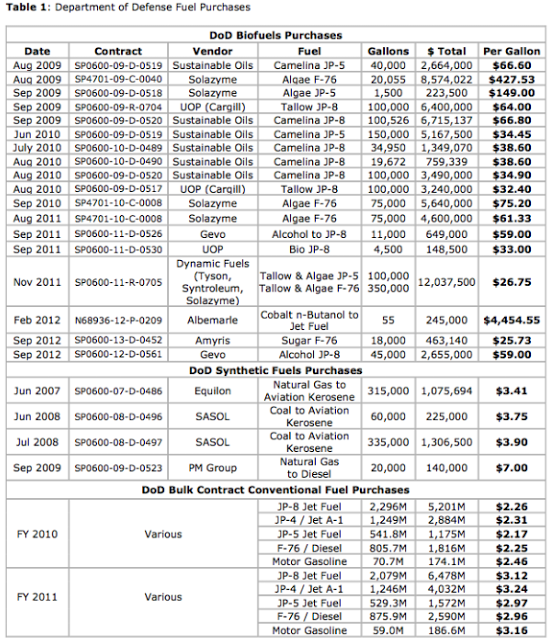Hi folks. Sorry for the sparse blog posts as I’ve been traveling these past few days, one for possible employment position, and today, I am currently at Saskatoon, Saskatchewan, for tomorrow’s Plant Bio-Industrial Oils Workshop.
I will be doing a live blog for this event so this should be exciting as it’s been a while since we had this type of post. If you’re on twitter, you can follow the hashtag #PBIO2013.
Meanwhile, let’s talk about this interesting chart below about the Department of Defense’s (DoD) biofuel purchases in the past few years.
This chart was taken from a paper (below) written by Captain Todd A. “Ike” Kiefer from the Department of Strategy at the US Air Force Air War College. This paper was also published this month in the US Air Force journal – Strategic Studies Quarterly.
[scribd id=128798250 key=key-twkfoqfxqcahe13ipzk mode=scroll]
As you can see, the author is definitely a critic of the DOD’s biofuel purchase, which are mostly for R&D purposes. Here are seven major arguments that he put in the paper regarding “insufficiency of biofuels as energy security.”
- Crippling fossil fuel dependence
- Deficient EROI (Energy Return on Investment) at scale
- Poor quality (energy density, power density, infrastructure and engine compatibility, need for hydrotreatment, etc.)
- Huge environmental impact (land and water footprint, nitrate poisoning (eutrophication) and agrochemical runoff, irreversible conversion of and damage to biodiverse habitat)
- Higher lifecycle GHG emissions (when properly counting land use change and all N2O, CH4, and CO2)
- Increased global instability (food competition, “green grabbing” land confiscation, displacement of native populations, pseudo-slave labor)
- Decreased energy security (higher cost, greater price volatility, annual production with no reserves, vulnerable to weather and crop failures, etc.)
According to the author, the cheapest price the Navy has paid for any biofuel to date is $1,123.50 per barrel, and that the military has spent $61.9m on 1.28m gallons of biofuel averaging more than $48/gallon or $2,000/bbl since 2007.
The DoD recently released a statement rebutting the paper, stating that the Department’s purchase of alternative fuels only refers to small quantities of test fuel as part of R&D programs. The Department is also said to be only looking to purchase drop-in alternative fuels for tactical use, and not ethanol or biodiesel.
The DoD went on to explain that the Department spends about $15bn a year on petroleum fuels for military operations – about 2% of their total budget – and more than $1bn on initiatives to improve operational energy use. Almost all of those initiatives are reportedly aimed at reducing the amount of fuel required in military operations.
The Department of Energy also commented that the author ignored or overlooked literatures with credible analyses and objective results of biofuels, and that some of the studies cited in the paper are out of date.
“The author was confused with present purchase prices of certain fuels for fleet testing versus the long term goals of government biofuel research and development (R&D) investment. The present purchase prices reflect current production at very limited scale and limited technology advancement. Government R&D investments are intended to overcome key technology barriers so that in the long term biofuels can become vital national energy options. If one uses the status quo to decide what society should or should not do, many technology innovations and civilization advancements would not have occurred.” – DOE
The author made a rebuttal response to the DoD and DOE’s statements and said that the agencies critique only his computational methodology, not the underlying fact of massive disadvantage to biofuels.
“It surprised me to hear that DoE does not consider fuel price or fuel density to be related to national security. The cost of energy is directly linked to stability of supply and to overall economic health. Energy density affects the fuel economy of vehicles and thus the number and length of convoys needed to supply fuel to the troops on the battlefield. The higher price of biofuels leaves less of the nation’s GDP for sustainment and growth, and the lower density of biofuels would require more fuel trucks on the battlefield subject to ambush and IED attack.” – Kiefer
Of course, this debate on biofuel will continue to go on and on until the advanced biofuel industry will be able to prove to critics that it can economically and sustainably compete against fossil fuels. However, this is a critical time for the biofuel industry when Congress are looking to cut back on military spending.
The Biotechnology Industry Organization (BIO) recently released a statement about the paper and the overall oil industry in general. According to BIO’s Brent Erickson, the DoD has to come up with an extra $1bn from its budget for every 25 cents rise in the price of jet fuel. In 2012, the increase in oil prices reportedly resulted in more than $3bn in unplanned Pentagon expenses, which had to be diverted from training, maintenance and other mission-essential programs.
“The paper recycles [their] old arguments against ethanol as a justification for abandoning the Navy biofuel effort. However, the military effort requires production of drop in fuels that match and blend with existing military specification jet fuels and marine diesels – not ethanol. Capt. Kiefer’s criticisms of the environmental impact of biofuels are never once compared to the growing environmental damage from marginal sources of petroleum.” – BIO





One response to “What are the real costs of biofuels?”
Thanks for sharing the real cost of biofuel.